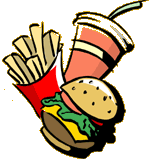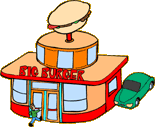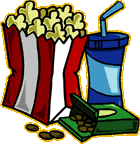If you’re like most people, a big chunk of your spending money goes to eating out with friends, having snacks, seeing movies, and just doing fun stuff out of the house. Let’s explore some ways to spend less while you’re having a good time!
Saving in Grocery and Convenience Stores
“Generics” vs. Brands
TV is flooded with ads for brand-name snacks, cereals, candy, drinks, and other foods. You probably know the names, logos, and cartoon spokespeople for these big-time national food brands. But are the name brands actually better? The companies that make them want you to think so, or they wouldn’t spend millions of dollars on all those ads. But guess what?
When it comes to any kind of food,
the only thing that matters is if you like it!
Here’s the truth: National brands of snacks, drinks, and cereals don’t cost more because they’re better; they cost more because the companies that make them have to pay for all that expensive advertising! In most cases, the local store brands or generic brands are just as good, and the prices are lower because they don’t waste money on fancy ad campaigns.
So why pay $3.00 for a bag of national brand tortilla chips just because everybody knows the name and there’s a cool cartoon animal on the bag? Try the less expensive bag, and see if you like it as much. If you do, you’ll be able to save some serious coinage!
Compare prices
The most important skill you need for saving money in supermarkets and food stores is called “comparison shopping.” This means looking at two or more brands of the same food and deciding which one is the better value. But since foods are packaged differently, and in different amounts (like a 6-pack of soda vs. a 2-liter bottle), this isn’t always easy.
The answer is on the shelf under or near the items: the unit price. This tells you the price of the food per unit (usually ounces) so you can compare things that are sold in different sized packages. For example: you want to compare two brands of fruit snacks, but one comes in an 8 oz. bag for $1.60, and the other in a 5 oz. box for $1.25. Look at the unit price:
- The one in the bag costs 20 cents per ounce
- The one in the box costs 25 cents per ounce
In this case, even though the box has a lower price, the brand in the bag is the better value because each ounce costs less than the ones in the box.
Use coupons
Coupons can be an easy way to save money in grocery stores, but we have to make sure we use them wisely. Here are some tips:
- Don’t let a coupon convince you to buy something you don’t want or like. If you spend money on something you don’t eat, you aren’t saving money at all.
- Make sure you’re getting a good deal. Coupons are usually for big national brands, which cost more than the store brands. Even with the money you save with the coupon, the store brand might still be a better deal.
- Avoid coupons that make you buy a whole bunch of different things to get the reduced price. If you have to buy cereal, milk, bread, and cake mix just to save a dollar, it probably isn’t worth it. Usually, you won’t need or want at least one thing on the list, so you’re actually spending more money than you save.
Saving in Restaurants
Look closely at combos and value meals
 They’re called combos, value meals, or meal deals. Most delis, restaurants, and fast food joints have them on the menu in order to make sure you get a drink and a side dish along with your main dish. Why do they do this? It’s not to save you money! Restaurants are in the business of making you spend more, not less, and the value meal exists because they make much of their profits from extras like drinks and fries. They need you to get a drink, fries, or chips so they can make more money off you!
They’re called combos, value meals, or meal deals. Most delis, restaurants, and fast food joints have them on the menu in order to make sure you get a drink and a side dish along with your main dish. Why do they do this? It’s not to save you money! Restaurants are in the business of making you spend more, not less, and the value meal exists because they make much of their profits from extras like drinks and fries. They need you to get a drink, fries, or chips so they can make more money off you!
Use this as your rule of thumb: If you were going to get a drink and a side dish anyway, you should go ahead and get the combo -- it might save you a little money. But if you want the small drink instead of the large, or you don’t need a drink because you have bottled water, or you just feel like a sandwich and don’t need the fries, don’t choose the combo.
Avoid the “upsell”
 Workers in fast food restaurants are trained to get you to buy the largest sizes by saying things like, “For just 50 cents more, you could get the extra-large soda instead of the medium!” But if this is more than you want (like with combo meals), you’re just throwing your money away. Don’t let a counter worker tell you what to get; instead, just order what you want. And here’s a tip: many restaurants offer free refills on soda, so buying the large size is a huge waste of cash!
Workers in fast food restaurants are trained to get you to buy the largest sizes by saying things like, “For just 50 cents more, you could get the extra-large soda instead of the medium!” But if this is more than you want (like with combo meals), you’re just throwing your money away. Don’t let a counter worker tell you what to get; instead, just order what you want. And here’s a tip: many restaurants offer free refills on soda, so buying the large size is a huge waste of cash!
Ignore the toy
A lot of fast food places offer free toys or little gadgets with their meal deals. They do this to get you to come back over and over so you can get the “complete set” of toys, or to convince you to buy something you don’t want in order to get the toy. Here are some tips to keep in mind:
- Don’t let a toy make you buy food you don’t like or want.
- Remember that something isn’t “collectible” just because someone says it is. Fast food toys are made in the millions, so they aren’t exactly rare or valuable.
- A lot of toy giveaways are cheaply made. How else could a restaurant afford to give them away with $4.00 worth of food?
- Too much fast food isn’t very healthy for you. If you’re eating burgers and fries several times a month in order to get free toys, you may be doing damage to your body (for more about this, see the IML section on Food Smarts).
Saving at Movies, Sports Events, and Theme Parks
Go easy on snacks
 Some people can’t stand to sit in a movie theater or watch a big game without popcorn, candy, or a big soda in their lap. But theaters, sports arenas, and parks pump up their prices big-time: a drink that costs $1.25 at a convenience store might cost $3.50 at a theater, and a bucket of popcorn you could make at home for 50 cents might cost $4.00 at the stadium! Of course, eating can be part of the day’s fun, but instead of spending all your money on food you can also:
Some people can’t stand to sit in a movie theater or watch a big game without popcorn, candy, or a big soda in their lap. But theaters, sports arenas, and parks pump up their prices big-time: a drink that costs $1.25 at a convenience store might cost $3.50 at a theater, and a bucket of popcorn you could make at home for 50 cents might cost $4.00 at the stadium! Of course, eating can be part of the day’s fun, but instead of spending all your money on food you can also:
- Eat at a favorite restaurant before or after the event.
- Bring in fast-food take out, if you’re allowed to do this.
- Bring in some food from home, then treat yourself to one item when you’re there.
- Give yourself a food budget for the event and stick to it.
Look for discounts
Movie theaters, sports arenas, and theme parks want people to come have fun, and if look for them, there are lots of opportunities to save money:
- Most theaters offer matinee prices or a discount for the first show of the day, and some even have “twilight” shows where ticket prices are lower for any movie starting before, say, 4:00 p.m.
- Check to see if your local theme park has special days with special rates, such as for families or people who live in the area, or if they’re offering online or newspaper coupons at the moment.
- Keep an eye out for promotional packages for sports teams, where the whole family can get tickets, snacks, and souvenirs for one set price.
- Your community organizations, place of worship, school, or parent’s employer may be able to get special coupons or passes to movies, sports events, and theme parks.
Skip the extras
Tempted to pick up a t-shirt or some other souvenir of your day? Most of us are. But keep in mind that these items are usually overpriced and may not seem as fabulous after you’re done with the fun and get them home. Instead, try these ideas:
- Give yourself a souvenir budget and stick to it! If you need to, ask a friend or parent to help you limit your spending during the day.
- Take a camera. Pictures might just end up being the best way to hold on to the fun memories.
Next up: Saving on Books, Music, and Video!
Previous



